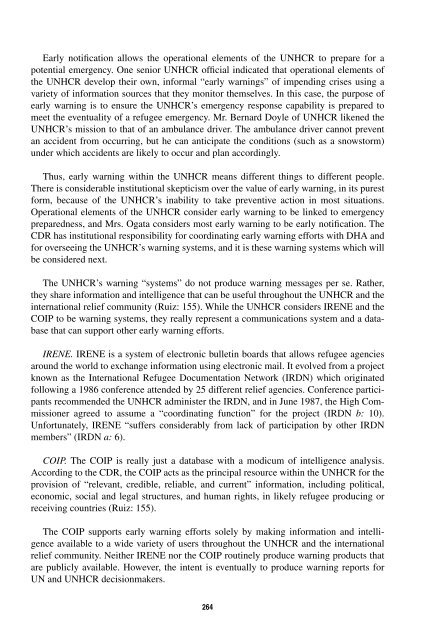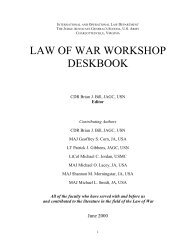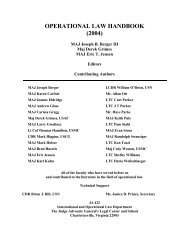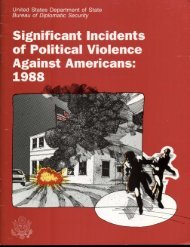learning with professionals - Higgins Counterterrorism Research ...
learning with professionals - Higgins Counterterrorism Research ...
learning with professionals - Higgins Counterterrorism Research ...
You also want an ePaper? Increase the reach of your titles
YUMPU automatically turns print PDFs into web optimized ePapers that Google loves.
Early notification allows the operational elements of the UNHCR to prepare for a<br />
potential emergency. One senior UNHCR official indicated that operational elements of<br />
the UNHCR develop their own, informal “early warnings” of impending crises using a<br />
variety of information sources that they monitor themselves. In this case, the purpose of<br />
early warning is to ensure the UNHCR’s emergency response capability is prepared to<br />
meet the eventuality of a refugee emergency. Mr. Bernard Doyle of UNHCR likened the<br />
UNHCR’s mission to that of an ambulance driver. The ambulance driver cannot prevent<br />
an accident from occurring, but he can anticipate the conditions (such as a snowstorm)<br />
under which accidents are likely to occur and plan accordingly.<br />
Thus, early warning <strong>with</strong>in the UNHCR means different things to different people.<br />
There is considerable institutional skepticism over the value of early warning, in its purest<br />
form, because of the UNHCR’s inability to take preventive action in most situations.<br />
Operational elements of the UNHCR consider early warning to be linked to emergency<br />
preparedness, and Mrs. Ogata considers most early warning to be early notification. The<br />
CDR has institutional responsibility for coordinating early warning efforts <strong>with</strong> DHA and<br />
for overseeing the UNHCR’s warning systems, and it is these warning systems which will<br />
be considered next.<br />
The UNHCR’s warning “systems” do not produce warning messages per se. Rather,<br />
they share information and intelligence that can be useful throughout the UNHCR and the<br />
international relief community (Ruiz: 155). While the UNHCR considers IRENE and the<br />
COIP to be warning systems, they really represent a communications system and a database<br />
that can support other early warning efforts.<br />
IRENE. IRENE is a system of electronic bulletin boards that allows refugee agencies<br />
around the world to exchange information using electronic mail. It evolved from a project<br />
known as the International Refugee Documentation Network (IRDN) which originated<br />
following a 1986 conference attended by 25 different relief agencies. Conference participants<br />
recommended the UNHCR administer the IRDN, and in June 1987, the High Commissioner<br />
agreed to assume a “coordinating function” for the project (IRDN b: 10).<br />
Unfortunately, IRENE “suffers considerably from lack of participation by other IRDN<br />
members” (IRDN a: 6).<br />
COIP. The COIP is really just a database <strong>with</strong> a modicum of intelligence analysis.<br />
According to the CDR, the COIP acts as the principal resource <strong>with</strong>in the UNHCR for the<br />
provision of “relevant, credible, reliable, and current” information, including political,<br />
economic, social and legal structures, and human rights, in likely refugee producing or<br />
receiving countries (Ruiz: 155).<br />
The COIP supports early warning efforts solely by making information and intelligence<br />
available to a wide variety of users throughout the UNHCR and the international<br />
relief community. Neither IRENE nor the COIP routinely produce warning products that<br />
are publicly available. However, the intent is eventually to produce warning reports for<br />
UN and UNHCR decisionmakers.<br />
264

















